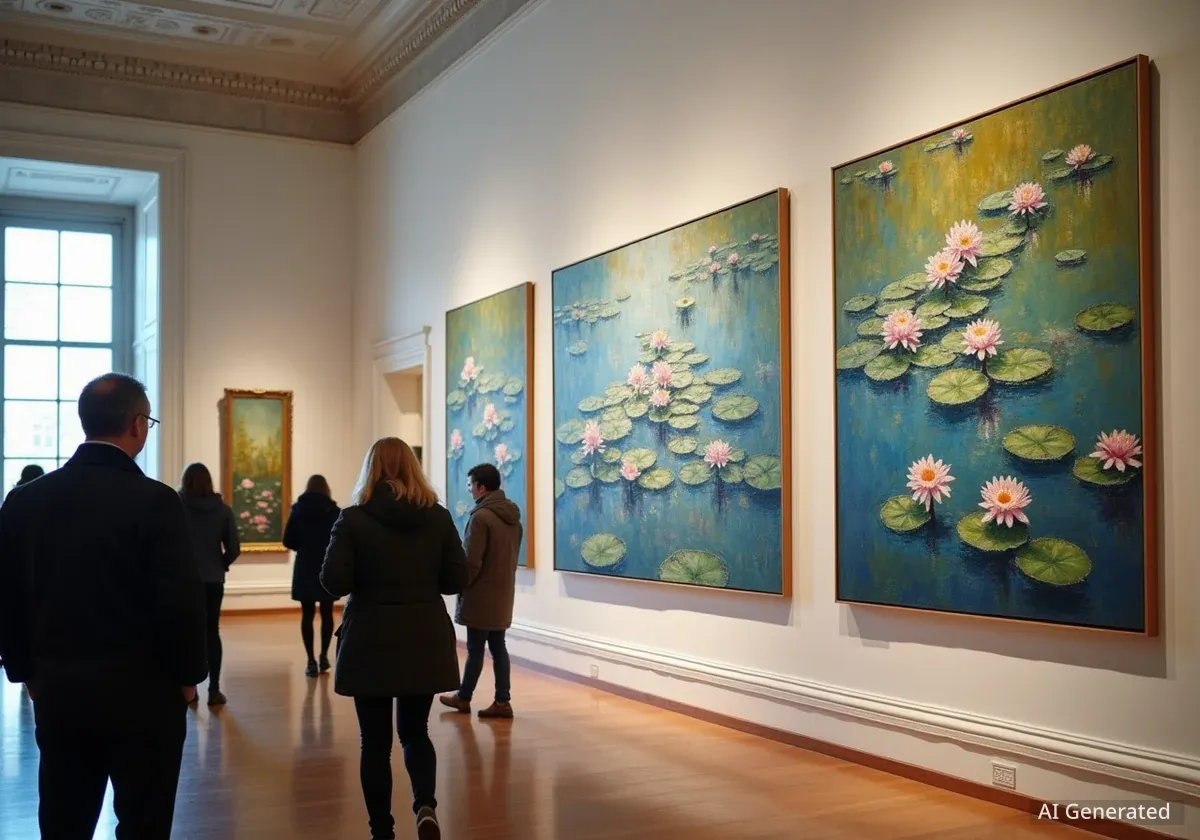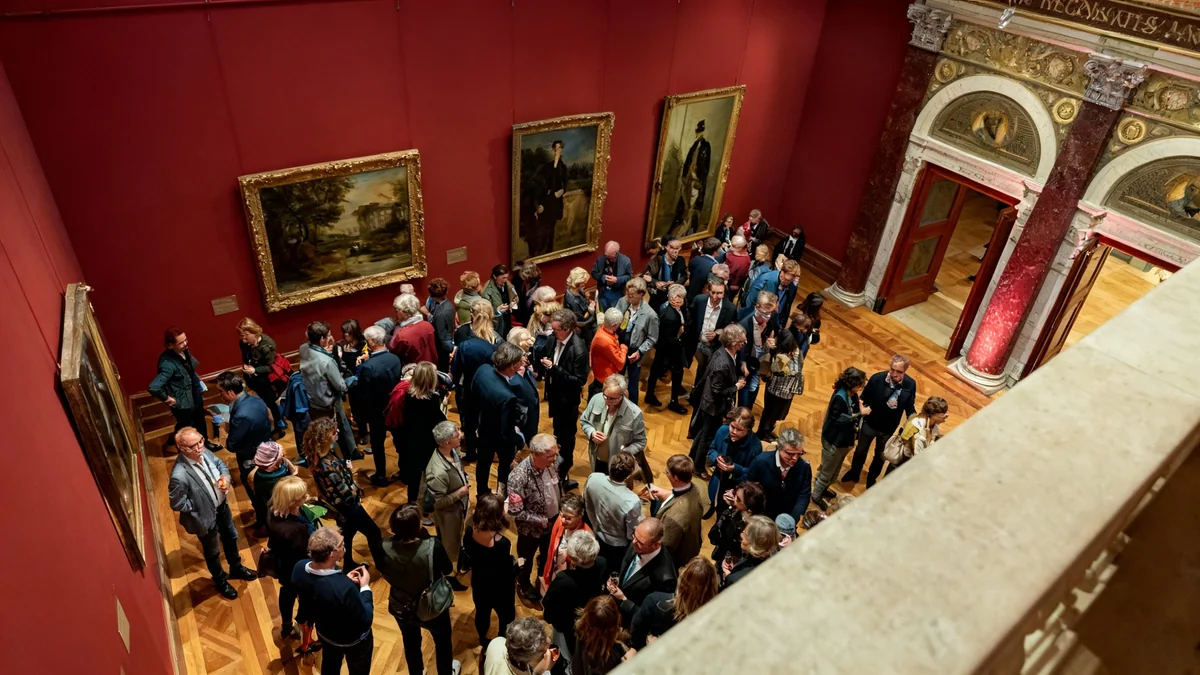A significant exhibition at the Brooklyn Museum highlights how Claude Monet’s 1908 trip to Venice revitalized his artistic approach and directly influenced his iconic 'Water Lilies' series. This focused show, titled 'Monet and Venice,' brings together more than half of the 37 paintings the Impressionist master created during his three-month stay in the Italian city, offering a fresh perspective on a lesser-known but crucial period in his career.
Key Takeaways
- Monet's 1908 Venice trip ended a creative block and reinvigorated his art.
- The exhibition features 37 Venetian paintings, with over half on display.
- Venice works led directly to his later, celebrated 'Water Lilies' series.
- Monet adopted a new, rigorous painting schedule in Venice, focusing on meteorological shifts.
- His Venetian style moved closer to abstraction, challenging traditional cityscapes.
Monet's Creative Struggle and Venetian Revival
In 1908, Claude Monet, a pivotal figure in French art, faced a creative challenge. His ongoing work on the 'Water Lilies' series was not progressing as he wished. His art dealer, Paul Durand-Ruel, recognized the issues with these new paintings. Monet postponed their exhibition multiple times before eventually canceling the show and temporarily abandoning the series.
However, by 1909, Monet's outlook had changed significantly. He felt refreshed and returned to the 'Water Lilies' with renewed energy and confidence. This period marked a late-career resurgence for the artist, who was then in his 60s.
Background on Monet's Career
Claude Monet (1840-1926) was a founder of French Impressionist painting. The term 'Impressionism' comes from the title of his 1872 painting, Impression, Sunrise. His work focused on capturing light and natural forms, often painting the same subject at different times of day to show changes in light and atmosphere.
The Venice Sojourn: A Turning Point
The Brooklyn Museum exhibition provides insight into this transformation. A three-month trip to Venice in 1908 allowed Monet to 'see my canvases with a better eye,' as he wrote in a letter to Durand-Ruel. This journey produced 37 distinct paintings. More than half of these works are now part of the New York exhibition, which opened on October 11.
When people imagine Monet's art, they often recall his Rouen Cathedral series, his haystacks, or his landscapes of Le Havre. His paintings of British Parliament, often seen through a misty haze, are also well-known. The Venice works, however, are less commonly recognized. The Brooklyn Museum show aims to change this perception.
“Monet and Venice,” as this exhibition is called, is nothing short of a revelation. If Monet never painted these Venice works, the exhibition persuasively suggests, he never would’ve reached his full creative potential.
The exhibition, a large-scale survey focusing almost entirely on the Venice series, pairs Monet's works with other artists' depictions of the city. These include vedute cityscapes by Canaletto and canal paintings by J. M. W. Turner. This approach highlights how Monet consciously worked against established artistic traditions.
Monet's Unique Approach to Venice
Monet initially hesitated to visit Venice, viewing it as an artistic cliché. Many artists, like John Ruskin, depicted the city in an idealized manner, often ignoring its contemporary realities. Ruskin's 1850–52 watercolor of the Palazzo Ducale, featured in the exhibition, for example, omits the gas lanterns installed by that time, presenting a romanticized view.
Monet found Venice 'too beautiful to be painted,' a statement that combined sincerity with a touch of sarcasm. However, his wife, Alice Hoschedé, persistently advocated for the trip. The couple eventually stayed at the Palazzo Barbaro, invited by Baroness Mary Hunter. A John Singer Sargent painting of the palazzo's owners, Daniel and Ariana Curtis, is also on display.
A New Painting Routine
In Venice, Monet continued his practice of painting outdoors, known as plein air, a technique that was revolutionary for Impressionism in the 1870s and 1880s. However, he adopted a new, strict work schedule. Instead of revisiting subjects at different times of day to capture the passage of time, as he did with his Rouen Cathedral and haystack series, he dedicated a specific two-hour window each day to his Venetian subjects.
This new method shifted his focus. He no longer aimed to represent the progression of time. Instead, he explored a more subtle form of transformation, driven by meteorological conditions.
Did You Know?
- Monet created 37 paintings during his three-month Venice trip.
- He famously said Venice was "too beautiful to be painted."
- His wife, Alice Hoschedé, persuaded him to visit the city.
Shifting Perspectives and Abstraction
The Brooklyn Museum groups several of Monet's paintings of the Palazzo Ducale, seen from the island of San Giorgio Maggiore. While these works appear similar at first glance, careful observation reveals subtle differences. For example, an embankment in the lower part of the paintings shifts in color, appearing bluish-grey in one and bruised purple in another. The palace itself moves in and out of focus, and the water of the Grand Canal transforms from white strokes to a pastel blur. These variations reflect how changes in weather affected the day's sunlight, which Monet meticulously captured on canvas.
Monet's Venice series directly challenged the prevailing artistic norms. While photographs of the era presented a static, peaceful Venice, Monet's canvases showed a city full of motion. His works also contrasted sharply with the highly detailed, almost photographic paintings of Canaletto. Monet's approach was deliberately smudgy and vague.
This style was not entirely new for Monet. His famous 1872 painting, Impression, Sunrise, already showed a preference for expressive brushwork, with just a few flecks of paint representing the waters of Le Havre's port. However, the Venice paintings pushed his practice further towards abstraction.
In The Rio della Salute (1908), for instance, the boundary between the purple walls of a palazzo and the water below becomes indistinct. The entire scene dissolves into a tangle of paint strokes. It becomes difficult to discern where the building ends and the natural environment begins. This blurring of lines represents a significant artistic development.
Legacy: From Venice to Water Lilies
The exhibition's final room is dedicated solely to the Venice series, presented in a blue-carpeted area with a newly commissioned musical score. While impressive, the exhibition suggests that Monet's true achievement with these works lies not just in the paintings themselves, but in the subsequent impact they had on his art.
Some of Monet's later 'Water Lilies' paintings, displayed in other galleries, are stunning examples of this evolution. One work from around 1914–17, on loan from the Fine Arts Museum of San Francisco, shows lilies rendered as swirls of pink and red paint. The lily pads appear as translucent loops of lime green, allowing a view of the pond beneath. An egg-colored cloud seems to exist both above and below the water simultaneously. This blurring of time and space mirrors the techniques seen in The Rio della Salute, but here, Monet ventures even further from recognizable figuration.
Critics widely praised these later 'Water Lilies' works, and they remain highly regarded today. Alice Hoschedé, Monet's wife, observed during their Venice trip that the city 'has got hold of him and won’t let go.' Tragically, she passed away in 1911, before witnessing the full impact of her encouragement on Monet's enduring legacy.
The Museum of Modern Art Connection
The influence of the Venice series is evident in some of Monet’s finest works, including the "Water Lilies" paintings that occupy an entire gallery at the Museum of Modern Art (MoMA) in Manhattan. These later works demonstrate a profound shift in his style, moving towards greater abstraction and a deeper exploration of light and reflection.




